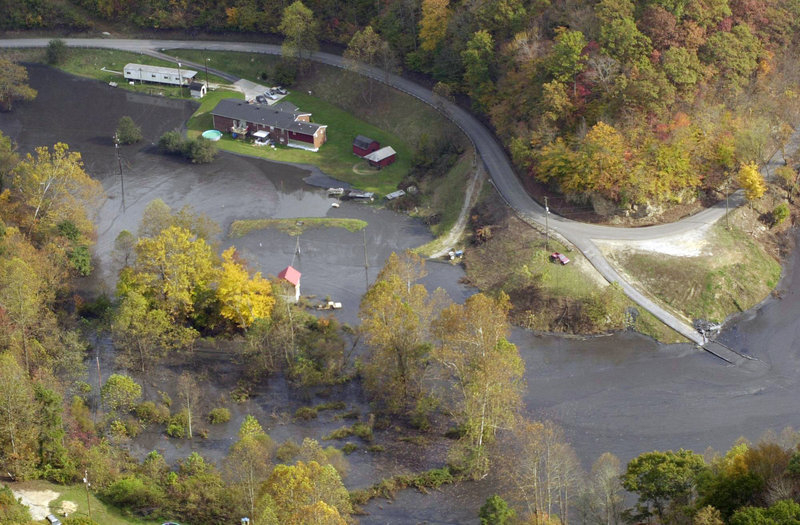LOUISVILLE, Ky. – In parts of eastern Kentucky, the pictures coming out of Hungary of the red sludge that roared from a factory’s reservoir, downstream into the Danube River, are all too reminiscent of what happened a decade ago this week.
A layer of dark goo still sits under a creekbed on Glenn Cornette’s land, the leftovers from when a coal company’s sprawling slurry pond burst, blackening 100 miles of waterways and polluting the water supply of more than a dozen communities before the stuff reached the Ohio River.
A torrent as wide as a football field and 6 feet deep covered Cornette’s property in Martin County, near the West Virginia line about 175 miles east of Louisville. It killed all manner of plants and cut off his access to the street.
“It just looked like pudding or something,” Cornette said recently.
With seven dead so far and at least 120 injured, the 184 million-gallon spill of toxic muck from a Hungarian alumina plant has already proven more dangerous than what’s known as the Inez disaster.
But the mess in Kentucky was considerably bigger — some 300 million gallons of slurry, a byproduct of purifying coal, oozed into yards and streams for miles in what was considered one of the South’s worst environmental disasters at the time.
And a decade later, its effects linger.
The slurry burst through the bottom of the Martin County Coal Corp.’s 68-acre holding pond early on the morning of Oct. 11, 2000, sending the goo washing through an underground mine and into two creeks.
The sludge blackened 100 miles of waterways, polluted the water supply of more than a dozen communities and killed aquatic life before reaching the Ohio River. There were no human casualties.
“The sludge looked like a flow of black lava,” said Mickey McCoy, an Inez resident whose creek was blackened by the spill. “We’re not talking brown water, we’re talking black, black lava just rolling.”
The coal company, a subsidiary of Richmond, Va.-based Massey Energy, eventually paid $46 million for the cleanup, along with about $3.5 million in state fines and an undisclosed sum to residents, including Cornette, who sued over property damages.
Because of the failure, Massey has studied its other slurry ponds, or impoundments, and hired outside experts to prevent another sludge release, company spokesman Jeff Gillenwater said. The impoundment site where the spill occurred is no longer in use, he said.
“The company is proud of the efforts it has undertaken to remediate the spill,” Gillenwater said in a recent e-mail.
Since the 2000 disaster, there have been 22 coal impoundment spills at Massey-owned sites, according to the Coal Impoundment Location and Information System, a database kept by Wheeling Jesuit University in West Virginia. Most were minor, and none approached the size of the release at Inez.
There are 285 active slurry ponds in 11 states, according to the federal Mine Safety and Health Administration. More than half are in Kentucky and West Virginia, with another 71 in Illinois and Pennsylvania.
The Martin County spill prompted MSHA to stiffen its sludge pond review process with closer attention paid to underground mining issues, spokeswoman Amy Louviere said.
Louviere provided a long list of measures MSHA has taken to improve oversight since the disaster, including increased training, publishing a new handbook on sludge impoundment management and requiring company engineers to thoroughly investigate underground mining in the area of the impoundment.
Mine safety advocate Tony Oppegard, a Lexington lawyer and former government regulator, said MSHA “basically missed the boat” with its investigative report of the Martin County disaster. The overriding issue was whether slurry ponds should be built above the active workings of coal mines, he said.
“It’s just a matter of time before you have another failure in one of them,” said Oppegard, who was MSHA’s lead accident investigator into the Martin County disaster until he was replaced when President George W. Bush took office.
The Martin County impoundment was supported by a relatively thin barrier of earth and rock — 15 to 18 feet — between the bottom of the sludge pond and an underground mine, said Jack Spadaro, former director of the National Mine Health and Safety Academy, which trains inspectors. Spadaro, who also led a team that looked into the spill for MSHA, said the pond was 80 feet deep when it burst.
The same slurry pond had a small release in 1994, and the company should have known the impoundment was at risk to fail again, Spadaro said. Instead, several dozen feet of sludge were added to the pond before the break in 2000.
Spadaro said MSHA could go further to prevent future coal slurry disasters, including better engineering evaluations of potential weak spots. He said MSHA continues to rely on engineering data provided by coal operators, just as it did in 2000.
Louviere said MSHA requires that the impoundments be designed by a professional engineer, and the agency’s role is to review the design. She said after the Martin County spill, evaluating the breakthrough potential at slurry pond sites has become routine in designing the impoundments.
McCoy said he visited fellow Inez resident Cornette’s home Oct. 3 to look for remaining sludge a decade later.
“I dug at the edge of the bank,” McCoy said. “Now this was in the water, and I pulled up a shovelful and threw it upside down on the bank and there was the sludge, under about 3 inches of sand.”
Send questions/comments to the editors.




Success. Please wait for the page to reload. If the page does not reload within 5 seconds, please refresh the page.
Enter your email and password to access comments.
Hi, to comment on stories you must . This profile is in addition to your subscription and website login.
Already have a commenting profile? .
Invalid username/password.
Please check your email to confirm and complete your registration.
Only subscribers are eligible to post comments. Please subscribe or login first for digital access. Here’s why.
Use the form below to reset your password. When you've submitted your account email, we will send an email with a reset code.